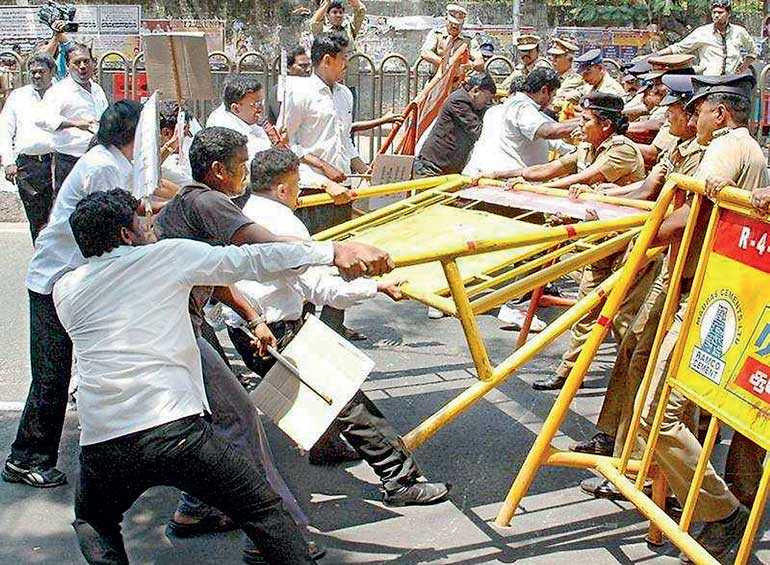Thursday Feb 13, 2025
Thursday Feb 13, 2025
Monday, 29 October 2018 00:05 - - {{hitsCtrl.values.hits}}

Tamil Nadu fights for Eelam: Chennai Police preventing lawyers during a demonstration in front of Customs House demanding a UN Referendum for Tamil Eelam in Sri Lanka – pic by UNI
One of the notable features of the current dynamics of Sri Lankan politics is the growing recognition by all parties in the country of India’s growing sensitivity to Sri Lanka’s major domestic political issues and changes. Historically viewed, this is a post-civil war phenomenon, which arose out of local misperceptions and misreads of India’s position and intensions regarding the unresolved Sinhalese-Tamil ethnic issue.
Even though the country is so close to India geographically, “so as to lose its insular character”, as K. M. Panikkarrightly assessed in his India and the Indian Ocean (1945: p.20), and is culturally entwined, it never became India’s satellite state, in spite of being drawn into the wars of the south Indian kingdoms either in self-defence, or in alliance with one or other of the warring princes.
Although the Kandyan kingdom was ruled by the Nayakkar dynastyfrom South India for three quarters of a century between 1739 and 1815 that kingdom remained independent and never fell under the tutelage of Dravidian India.
Even colonial Britain ruled Ceylon as a separate crown colony and not as part of India. After independence in 1948 and until the rise of LTTE, India rarely intervened in Sri Lankan domestic political affairs except when called for military assistanceSri Lankan governments, as was the case in the abortive coup d’etatof 1962 and JVP led youth insurrection of 1971.
True, the strategic location of Trincomalee harbour and events surrounding its ownership and control has always been a concern in India’s naval strategy, because India, asstressed by Panikkar,is determined tokeep “The Indian Ocean … remain fully Indian” (op.cit., p. 84). However, Trincomalee was never an issue between India and Sri Lanka until China entered Sri Lankan waters after the civil war by gaining a 99-year leasehold over Hambantota harbour.
Likewise, even the issue of status of Indian immigrants in the island, a legacy of British colonialism, was settled amicably and with great statesmanship by the Sirimavo-Shastri Pact of 1964 and Sirimavo-Indira Pact of 1974. This mutual recognition of and non-interference in each other’s domestic politics has changed dramatically since the end of the civil war.
The ubiquity of India’s intelligence agency Research and Analysis Wing(RAW) and the regularity of visits by Sri Lankan leaders to Delhi and vice versa for advice and consultation eloquentlyannounces the permanency of Indian interest in Sri Lankan politics.How did this happen? To answer this question one has to understand the contradictory perceptions or rather misperceptions that the Sinhalese and Tamil leadership carried about India’s position and intentions regardingthe ethnic issue.
Leaders of both communities grossly misread India’s position and motives in the ethnic crisis, which eventually brought the civil war with disastrous economic and strategic consequences. The Sinhalese intelligentsia, the Buddhist prelates and political leaders had a mortal fear in their mindset fed by partisan historians, archaeologists, political thinkers, novelists and dramatists that India would one day invade Sri Lanka in support of the Tamils.
This fear was ingrained in their psyche through distorted pictures about Tamil invasions from South India during the medieval era. That fear understandably became intense when Tamil leaders and especially their LTTE subset, over confidently and overwhelmingly,fulminated about Indian Tamil brethren’s readiness to assist in case of war breaking out between the two communities.
The willingness of Tamil Nadu rulers, in concert with Delhi leadership, to supply weapons and train Eelam warriors on Indian soil added further to Sinhalese fear and built Tamil hopes. Ultimately, when the Indian air force provocatively intruded Sri Lanka’s air-space and dropped relief supplies on the Jaffna Peninsula on 4 June 1987 following the failure to send a day before a flotilla of ships loaded with similar cargo the contradictory feelings of both communities reached their respective zenith. Yet, when the war actually broke out and moved towards its tragic crescendo the fear of the Sinhalese and hopes of the Tamils evaporated simultaneously, one with jubilation and the other with disappointment and agony.Both groups misperceived and misread India’s position and intentions.
From the point of view of India’s national security Sri Lankan ethnic issue was a non-issue to receive serious attention. Historically, the threat to India’s security always came from the north and not from the south. This was why Indira Gandhi showed keen interest in the then growing separatist troubles between East and West Pakistan, sent Indian forces to assist Mujibur Rahman’s MuktiBahini and actualised the cause of an independent Bangladesh.
India had to do it for strategic reasons to weaken its arch rival Pakistan against whom she fought three wars. India’s role and interference in this episode raised false hopes among the Tamils that it will do the same in their struggle for an independent Eelam.This was the first misread of India’s tactical and discriminatory interference in the politics of neighbouring countries.
The fact that Delhi tolerated Tamil Nadu’s red carpet reception to Sri Lankan separatist factions and even Delhi’s preparedness to provide limited supply of arms and training to Tamil fighters was not because of Delhi’s support to the Tamil struggle for a separate state but because to keep the Tamil Nadu state government on the side of the Central government in Delhi. The need for a central government’s stability and continuity in a federal democracy often produces situations that make compromises on unpalatable demands from state governments unavoidable. Such internal diplomatic manoeuvres between Delhi and Chennai werealso misperceived by Sri Lankan Tamil leaders as Tamil Nadu’s overriding influence over the central government. Also, little did those leaders ponder whether the Tamil Nadu politicians themselves supported the emergence of an independent Tamil Eelam. The late Cho Ramaswamy, a Tamil Brahmin journalist, lawyer and comedian,was quite critical of the hypocrisy of Tamil Nadu politicians such as Karunanidhi, Ramachandran and Jeyalalitha (all of them are dead)for manipulating the Sri Lankan Tamil issue simply to win their own political contests and no more.
Objectively speaking, an independent Tamil Eelam will be detrimental to the international status and reputation of Tamil Nadu. In a short note that I published in the London Tamil Times in 1986 I analysed this point which obviously disturbed a number of Eelamists and their fellow travellers.Let me summarise my argument.Even though Tamil Nadu is only a state government and not an independent country, it is, for all intents and purposes, the sole spokesperson in the global arena regarding Tamil language, Tamil culture and Tamil civilization. This is a prestigious situation. However, that position is bound to be jeopardised once anindependent Tamil Eelam is created and recognised internationally. That tiny country with a flag of its own would then have a representative in the UN and that representative would automatically become the sole voice of any Tamil issue raised at world stage. Will Tamil Nadu be prepared to surrender its hegemony to a Tamil Eelam, ruled by leaders, who, in the caste ladder of Indian Brahmanismare not equal even to its lowest rung? Also, from the point of view of Delhi, the tiny Tamil country may even re-energize separatist Dravidian ethnic feelings in Tamil Nadu, which was successfully controlled and subsumed in 1950s under territorial federalism.Finally, instead of one, two independent countries in one small island, but both sharing the same land borders along the Indian Ocean would complicate India’s any future negotiations for maritime security.Thus, neither Delhi nor Chennai was really committed to support Tamil Eelam struggle. The thirty minutes token hunger strike, in sympathy with Sri Lankan Tamils, by Tamil Nadu Chief Minister, Karunanidhi, at a time when tens of thousands of Tamils were trapped in a redoubt and facing slaughter at the hands of Sri Lankan soldiers exposed Tamil Nadu’s hypocrisy beyond any doubt.
Had these facts been understood by the leaders of the two communities a civil war would have been averted. While an ungrounded fear of India drove Sinhalese politicians to shop around for weapons from multiple source with borrowed money, an overconfident Tamil leadership relying on Tamil Nadu’s false promises rejected all solutions for a peaceful settlement. Even with all the advantage of superior weapons and larger size of soldiery it was the crucial neutrality of Delhi that actually won the war for the Sri Lankan government. To that,Sri Lankan governments irrespective of their hues are heavily indebt. It was India’s master stroke. India is finally in Sri Lanka without firing a shot.The country has paid a very heavy price for its misperceptions and misreads.
However, the sudden sacking of Prime Minister RW by President MS on Friday 26 October, after the PM returned from a recent visit to India, is seen by observers as an attempt by the President to keep India at bay. The newly appointed PM and former President MR, who is yet to prove his majority support in the parliament when it reconvenes on 16 November, is known to be closer to Beijing than Delhi. At the moment there are two PMs and one headman. India’s RAW will be closely watching these developments, and looking from a distance, they do not auger well for Sri Lanka’s political stability and economic future.
(The writer is from School of Business and Governance, Murdoch University, Western Australia.)
Discover Kapruka, the leading online shopping platform in Sri Lanka, where you can conveniently send Gifts and Flowers to your loved ones for any event including Valentine ’s Day. Explore a wide range of popular Shopping Categories on Kapruka, including Toys, Groceries, Electronics, Birthday Cakes, Fruits, Chocolates, Flower Bouquets, Clothing, Watches, Lingerie, Gift Sets and Jewellery. Also if you’re interested in selling with Kapruka, Partner Central by Kapruka is the best solution to start with. Moreover, through Kapruka Global Shop, you can also enjoy the convenience of purchasing products from renowned platforms like Amazon and eBay and have them delivered to Sri Lanka.
Discover Kapruka, the leading online shopping platform in Sri Lanka, where you can conveniently send Gifts and Flowers to your loved ones for any event including Valentine ’s Day. Explore a wide range of popular Shopping Categories on Kapruka, including Toys, Groceries, Electronics, Birthday Cakes, Fruits, Chocolates, Flower Bouquets, Clothing, Watches, Lingerie, Gift Sets and Jewellery. Also if you’re interested in selling with Kapruka, Partner Central by Kapruka is the best solution to start with. Moreover, through Kapruka Global Shop, you can also enjoy the convenience of purchasing products from renowned platforms like Amazon and eBay and have them delivered to Sri Lanka.